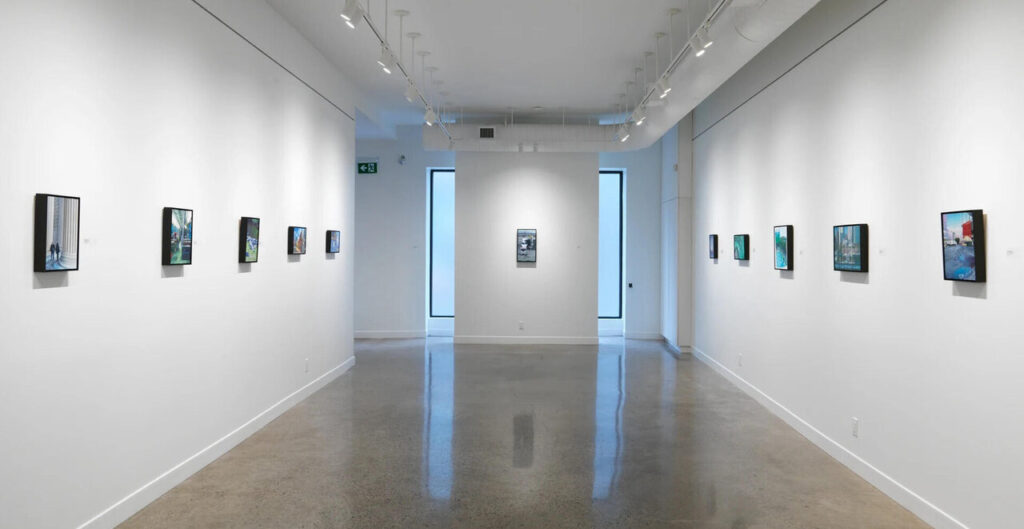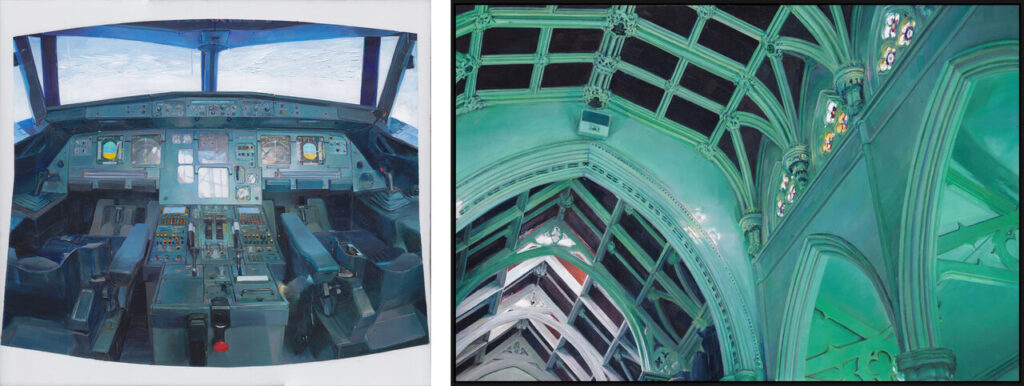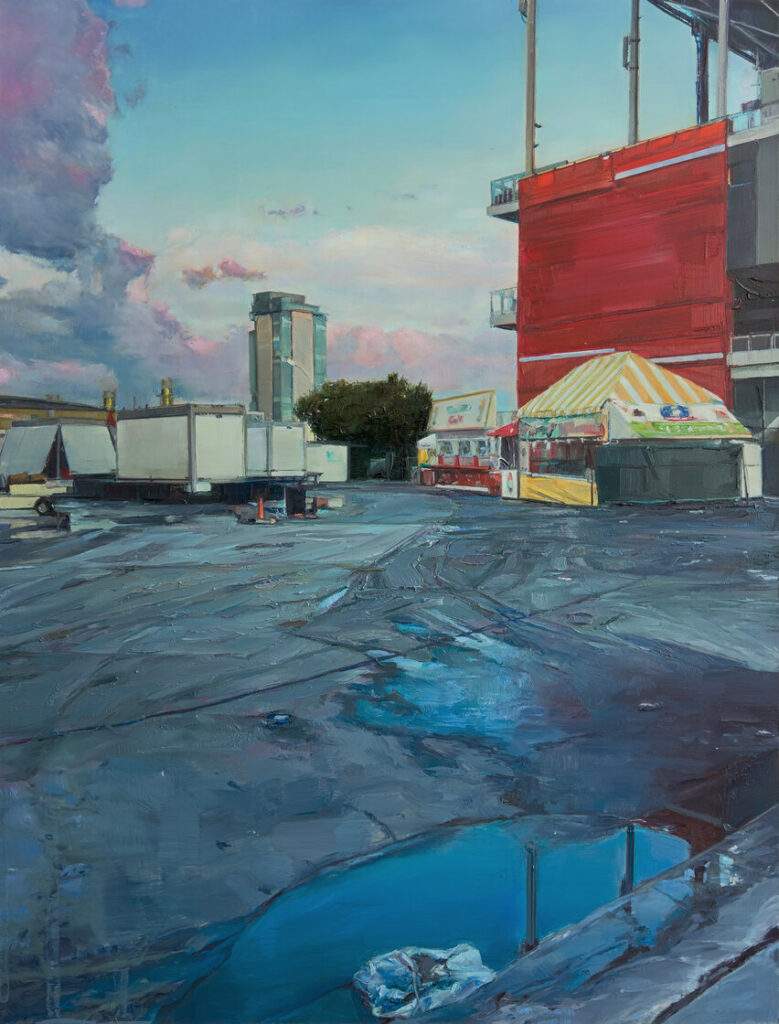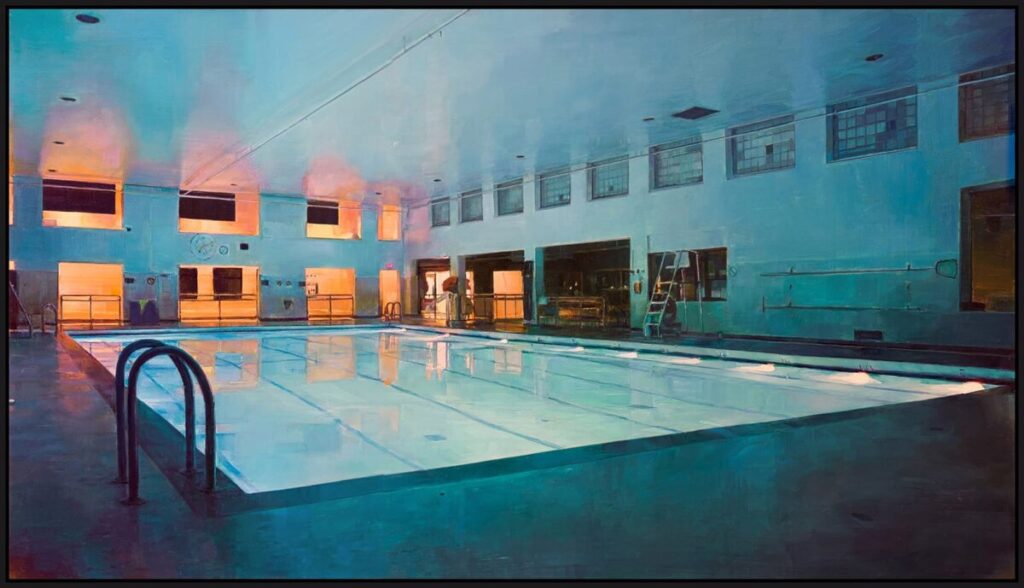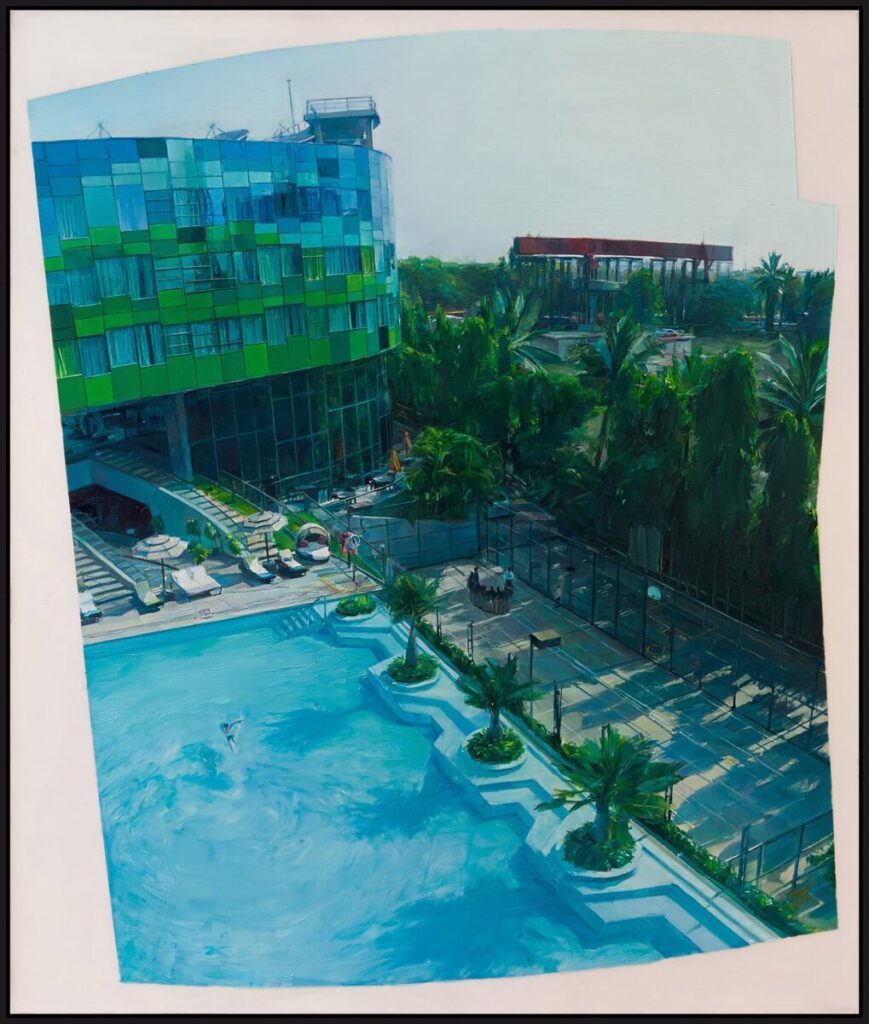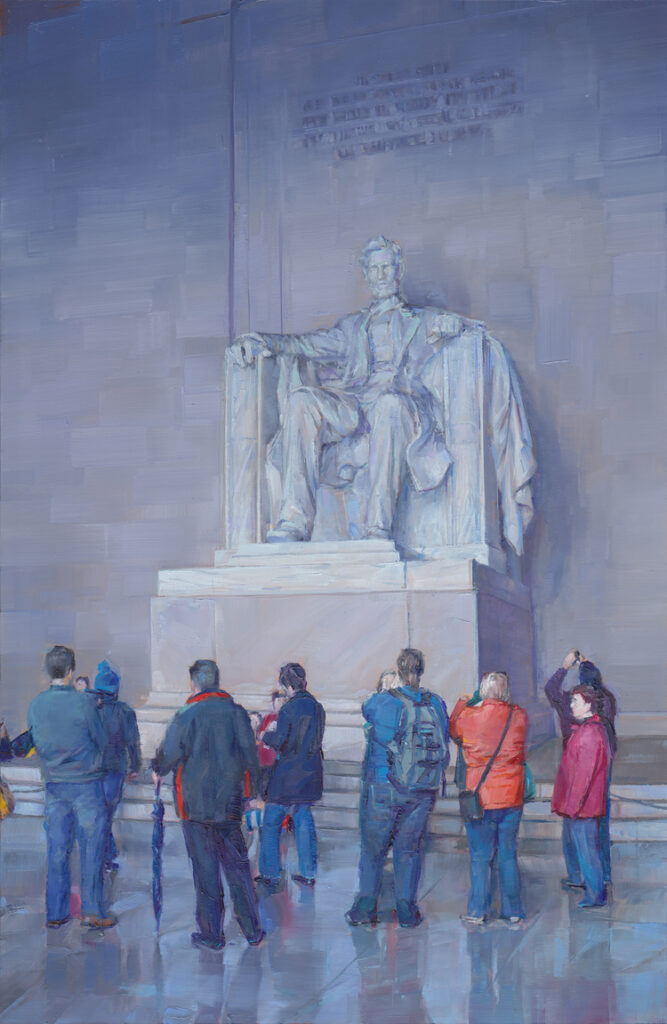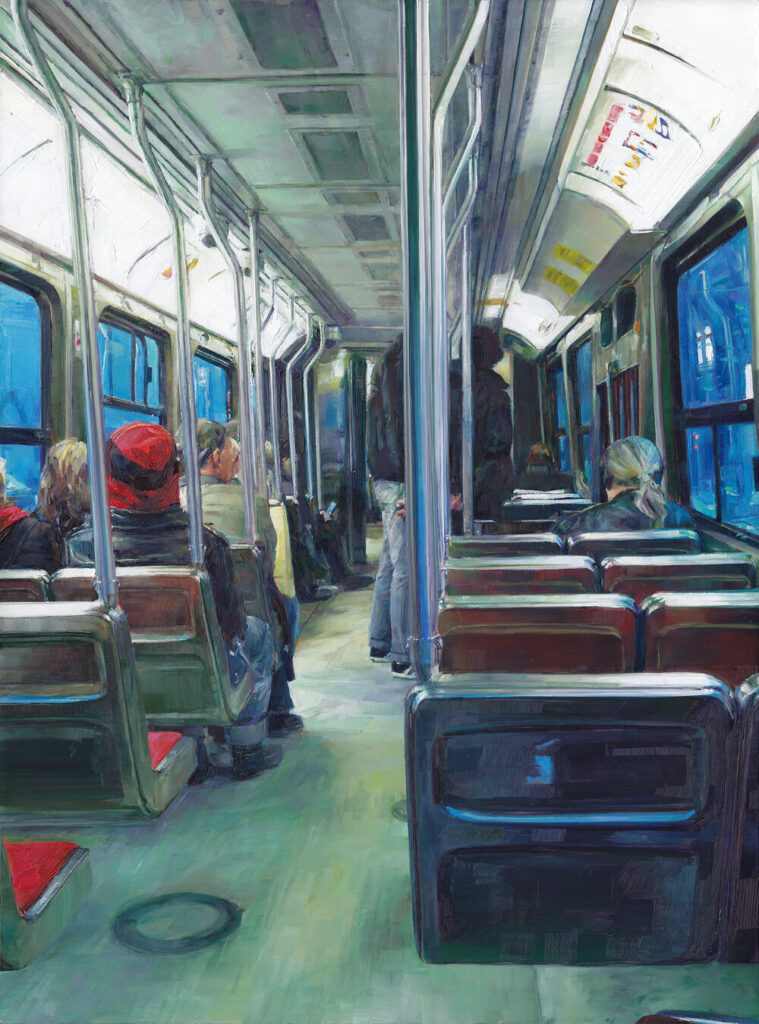Visitors are greeted by images of the Reichstag in Berlin in the pitch black of the night, an empty basketball court at dusk, and a morning swim at a Bangalore hotel. These are artworks from Matthew Schofield’s latest exhibition at the Nicholas Metivier Gallery. Set against the white walls of the gallery and enclosed in thin black frames, Schofield’s small paintings of everyday photographs glow with jewel-like quality. Viewers must step close, giving themselves over to the notion of ‘force majeure’; the uncontrollable and unforeseen events that create changes in our surroundings.
Installation view of Matthew Schofield: Force Majeure, © Joseph Hartman
In earlier periods of his career, Schofield worked with printed photographs taken by other people. In Force Majeure, he uses digital files he had captured himself over the span of two decades. This allowed him to zoom in on details, even stitching multiple photographs together to create the compositions that he brings to life in paint.
Where the original photograph dilutes these experiences into a singular moment, Schofield’s stitching brings a series of moments together, blending them into one synoptic moment that gains permanence through his brush strokes. This permanence is not static; instead, each image seems to beat with a pulse. The yellow buttons in Cockpit at the Smithsonian twinkle on the panel. The light entering through the stained-glass windows in Church Ceiling glows softly, maybe even dances a little. Schofield’s method of oil painting and his unique use of light creates this iridescent quality. In Force Majeure Schofield is recasting photographs he has experienced in more than just a two-dimensional state. Perhaps this is why he lays his paint down in such thick strokes – building up layers and layers of colour that further animate his works.
Matthew Schofield, Cockpit at the Smithsonian, 2022, oil on mylar on aluminum panel, 11.375 x 12.75 in (left) & Church ceiling, 2022, oil on mylar on aluminum panel, 9.7 x 14.5 in (right)
Each image is occurring in a different location, still the viewers get the sense that there is something tying them together as an outcome of the artist’s act of sifting through images from the past and choosing to revisit them. In the process, Schofield returns to places he visited decades ago, immersing himself in encounters long since forgotten. Describing this process in the exhibition text, he notes: “I started to go through old digital photographs, and I was struck by how I’ve changed from the person that took the photograph several years ago. It’s not the same person that is going to do a painting of the photograph. I’m intrigued by this notion of self-exploration over the distance of time.”
Despite Schofield’s fascination with the human psyche, most of his compositions are vacant of humans. In The End of The Day, viewers look on at a fair a few hours after closing. There are no people, but there is the sense that there once had been. That once it was a bustling menagerie of children and melting ice cream cones. A yellow and white striped tent sits boarded up in the background. We can visualize the gleeful exchanges of balloon animals and plush toys that occurred in the windows. The cotton candy clouds are all that is left, sinking down into the abandoned lot.
Matthew Schofield, The End of the Day, 2021, Oil on mylar on aluminum panel, 13 x 10 in
In Trinity Bellwoods pool, an amber light emanates from the back hallway. In the foreground, an empty pool reflects this warmth. The water is still, untouched in the throes of COVID-19.
Matthew Schofield, Trinity Bellwoods pool, 2022, oil on mylar on aluminum panel, 11.25 x 19.8 in
In other works, people flutter across the panel, never locking eyes with the photographer. In Taj Hotel in Bangalore, a man is about to complete a lap in the pool while a group of hotel staff is being given their orders for the day. The early morning light cuts through the trees and illuminates the court. To the left of the staff, the swimmer leaves a wake of disturbed water behind him; ahead of him, the water sits still in apprehension of his arms and legs slicing through it. In this painting, Schofield provides viewers with a glimpse into both the moments that came before and the action that is about to occur. In the background, a half built light rail system towers over the greenery. Viewers can imagine the bustling of commuters, the screeching of the trains against the steel tracks, the muffled announcements that will soon disturb the peace of the hotel.
Matthew Schofield, Taj Hotel in Bangalore, 2022, oil on mylar on aluminum panel, 14.5 x 12.25 in
We navigate around the rectangular space of the gallery, looping multiple times, gliding from one painted world to another. Nestled in the farthest corner of the room, a flat screen TV sits on a stand. Viewers experience the process behind the works they are immersed in. As the original photographs glide across the screen, Schofield tells us about a camera that shuts down when users attempt to take pictures of cliché tourist sights. The camera pulls focus toward ordinary moments that tend to go un-memorialized and unremembered. Schofield does this himself through his practice. In Daniel Chester French Sculpture of Lincoln, he paints a small crowd of tourists taking photographs of the monument. Their lenses point toward the statue of Abraham Lincoln; Schofield’s focuses in on them.
Matthew Schofield, Daniel Chester French Sculpture of Lincoln, 2022, oil on mylar on aluminum panel 10.75 x 7.25 in
Matthew Schofield’s paintings also depict places we feel like we have experienced before. On the streetcar home after the exhibition, I found myself inside his Streetcar. The streetcar I am on is newer (somewhat dirtier) but I look at my fellow passengers and feel an urge to remember this moment, that it is exactly the sort of moment Schofield encourages us to take in and memorialize in our own way.
Matthew Schofield, Streetcar, 2022, oil on mylar on aluminum panel, 12.75 x 9.5 in
Shakuntala Fernandopulle
Images are courtesy of the artist and Nicholas Metivier Gallery
*Exhibition information: Matthew Schofield, Force Majeure, January 28 – February 18, 2023, Nicholas Metivier Gallery, 190 Richmond Street East, Toronto. Gallery hours: Tue – Sat, 10am – 5pm.

